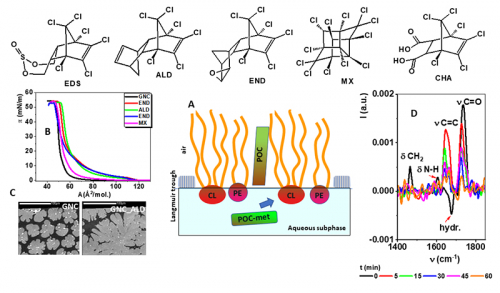Study of model bacterial membranes to accelerate toxin’s decomposition
In the forties of the XXth century, multiple highly chlorinated organic molecules were introduced to American and later on to European agriculture as potent and versatile pesticides. Indeed, in the first years of their applications, they lead to large increase of the yields per hectare and to the eradication of multiple pests. In the post-war years, virtually nobody thought about the long-term consequences of their application and the possible negative consequences. The whistle blower was American marine biologist Rachel Carson publishing in 1962 the alarming book “Silent Spring” about the catastrophic consequences of the application of polychlorinated organics (PCO). Her work lead to the beginning of the environmental movements, the establishment of the Environmental Protection Agency (EPA) in the USA by president Nixon and multiple regulation. Finally, PCO were banned in most countries around the year 2000 which is also the consequence of the international Stockholm Convention on persistent organic pollutants.
The problem is that PCO are bio-accumulative and very slowly degradable; thus, the large amounts of PCO accumulated in the soils will be a threat for human and the environment during many decades. The only option for the elimination of PCO from the soils is bioremediation – that is the introduction of proper bacterial species to the soil which can degrade PCO.
However, PCO are highly hydrophobic, so they can easily accumulate in the cellular membranes of any bio-remediative bacteria and kill them. Therefore, the applied bacteria should have a specific phospholipid composition of their membranes which can render them durable and effective in PCO degradation.
To find such compositions and shed light on the PCO-bacterial membrane interactions, the scientists applied Langmuir monolayers formed from phospholipid mixtures as versatile models of bacterial membranes. Langmuir monolayers are deposit of molecules exhibiting both hydrophilic and hydrophobic character as mono-molecular layers at the air / water interface. Using phospholipid molecules to form Langmuir monolayers enable to mimic one leaflet of the membrane of living cells and to test the effects of the most toxic PCO and their metabolites on membrane structure.

Figure 1: Upper row – structural formulae of the investigated PCO: endosulfan (EDS), aldrin (ALD), endrin (END), mirex (MX) and chlorendic acid (CHA); A) General scheme of the experiment, B) selected surface pressure – Area isotherms, C) selected Brewster angle microscopy images, D) selected PM-IRRAS spectra
The scientists prepared model membranes of Gram-negative and Gram-positive soil bacteria by mixing appropriate amounts of bacterial phospholipids: cardiolipin (CL) phosphatidylethanolamine (PE) and phosphatidylglycerol (PG). Four most environmentally widespread PCO and their metabolites were introduced to the model membranes and the effects of their incorporation were monitored.
In their studies, the authors combined microscopic, spectroscopic and synchrotron techniques to have an in-depth insight into the studied systems. Especially important was the application of the Grazing Incidence X-ray Diffraction method accessible in the SIRIUS beamline of SOLEIL. The phospholipids in the model membranes were periodically organized in a 2D lattice, and the effects of the PCO on the packing mode was correlated with their toxicity.

Figure 2: Selected Grazing Incidence X-ray Diffraction results. Upper row: intensity maps I(Qxy,Qz). Lower row: Bragg peaks I(Qxy) and Bragg rods I(Qz) calculated from the above intensity maps.
The studies proved that the presence of PCO at the air / water interface exerted a much higher effect on the models of Gram-negative than Gram-positive bacterial membranes. This demonstrates the protective role of cardiolipin, which is abundant in the membranes of Gram-positive bacteria.
Thus, in the bioremediation of PCO-polluted soils, selected species of Gram-positive bacteria, whose membranes are rich in cardiolipin, should be applied.
